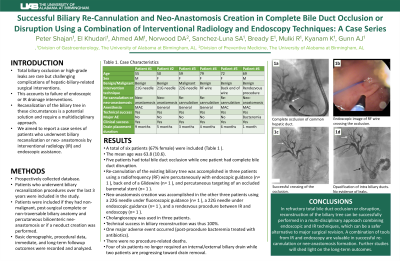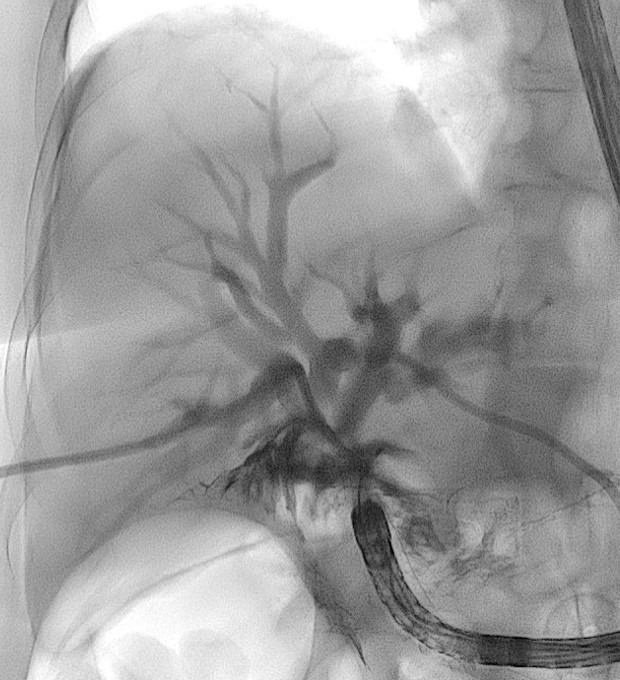Monday Poster Session
Category: Interventional Endoscopy
P2289 - Successful Biliary Re-Cannulation and Neo-Anastomosis Creation in Complete Bile Duct Occlusion or Disruption Using a Combination of Interventional Radiology and Endoscopy Techniques: A Case Series
Monday, October 23, 2023
10:30 AM - 4:15 PM PT
Location: Exhibit Hall

- SP
Shajan Peter, MD
University of Alabama at Birmingham
Birmingham, AL
Presenting Author(s)
Award: Presidential Poster Award
Shajan Peter, MD1, Husameddin El Khudari, MD1, Ali Mir Ahmed, MD1, Dalton A. Norwood, MD2, Sergio A. Sánchez-Luna, MD3, Eric Bready, MD1, Ramzi Mulki, MD3, Kondal Kyanam, MD3, Andrew J Gunn, MD1
1University of Alabama at Birmingham, Birmingham, AL; 2UAB Minority Health and Health Equity Research Center, The University of Alabama at Birmingham Heersink School of Medicine, Birmingham, AL; 3Basil I. Hirschowitz Endoscopic Center of Excellence, The University of Alabama at Birmingham Heersink School of Medicine, Birmingham, AL
Introduction: Total biliary occlusion or high-grade leaks are rare but challenging complications of hepatic-biliary-related surgical interventions. This accounts to failure of endoscopic or IR drainage interventions. Recanalization of the biliary tree in these circumstances is a potential solution and require a multidisciplinary approach. We aimed to report a case series of patients who underwent biliary recanalization or neo- anastomosis by interventional radiology (IR) and endoscopic assistance.
Methods: Patients who underwent biliary recanalization procedures over the last 3 years were included in this IRB-approved study of a prospectively collected database. Patients were included if they had non-malignant, post-surgical complete or non-traversable biliary anatomy and percutaneous bilioenteric neo-anastomosis or if a neoduct creation was performed. Basic demographic, procedural data, immediate, and long-term follow-up outcomes were recorded and analyzed.
Results: A total of six patients (67% female) were included (Table 1). The mean age was 63.8 (10.6). Five patients had total bile duct occlusion while one patient had complete bile duct disruption. Re-cannulation of the existing biliary tree was accomplished in three patients using a radiofrequency (RF) wire percutaneously with endoscopic guidance (n=1), back end of a Glidewire (n=1), and percutaneous targeting of an occluded bare-metal stent (n=1). Neo-anastomosis creation was accomplished in the other three patients using a 22G needle under fluoroscopic guidance (n=1), a 22G needle under endoscopic guidance (n=1), and a rendezvous procedure between IR and endoscopy (n=1). Cholangioscopy was used in three patients. Technical success in biliary reconstruction was thus 100%. One major adverse event occurred (post-procedure bacteremia treated with antibiotics). There were no procedure-related deaths. Four of six patients no longer required an internal/external biliary drain while two patients are progressing toward drain removal.
Discussion: In refractory total bile duct occlusion or disruption, reconstruction of the biliary tree can be successfully performed in a multi-disciplinary approach combining endoscopic and IR techniques, which can be a safer alternative to major surgical revision. A combination of tools from IR and endoscopy are valuable in successful re-cannulation or neo-anastomosis formation. Further studies will shed light on the long-term outcomes.

Disclosures:
Shajan Peter, MD1, Husameddin El Khudari, MD1, Ali Mir Ahmed, MD1, Dalton A. Norwood, MD2, Sergio A. Sánchez-Luna, MD3, Eric Bready, MD1, Ramzi Mulki, MD3, Kondal Kyanam, MD3, Andrew J Gunn, MD1. P2289 - Successful Biliary Re-Cannulation and Neo-Anastomosis Creation in Complete Bile Duct Occlusion or Disruption Using a Combination of Interventional Radiology and Endoscopy Techniques: A Case Series, ACG 2023 Annual Scientific Meeting Abstracts. Vancouver, BC, Canada: American College of Gastroenterology.
Shajan Peter, MD1, Husameddin El Khudari, MD1, Ali Mir Ahmed, MD1, Dalton A. Norwood, MD2, Sergio A. Sánchez-Luna, MD3, Eric Bready, MD1, Ramzi Mulki, MD3, Kondal Kyanam, MD3, Andrew J Gunn, MD1
1University of Alabama at Birmingham, Birmingham, AL; 2UAB Minority Health and Health Equity Research Center, The University of Alabama at Birmingham Heersink School of Medicine, Birmingham, AL; 3Basil I. Hirschowitz Endoscopic Center of Excellence, The University of Alabama at Birmingham Heersink School of Medicine, Birmingham, AL
Introduction: Total biliary occlusion or high-grade leaks are rare but challenging complications of hepatic-biliary-related surgical interventions. This accounts to failure of endoscopic or IR drainage interventions. Recanalization of the biliary tree in these circumstances is a potential solution and require a multidisciplinary approach. We aimed to report a case series of patients who underwent biliary recanalization or neo- anastomosis by interventional radiology (IR) and endoscopic assistance.
Methods: Patients who underwent biliary recanalization procedures over the last 3 years were included in this IRB-approved study of a prospectively collected database. Patients were included if they had non-malignant, post-surgical complete or non-traversable biliary anatomy and percutaneous bilioenteric neo-anastomosis or if a neoduct creation was performed. Basic demographic, procedural data, immediate, and long-term follow-up outcomes were recorded and analyzed.
Results: A total of six patients (67% female) were included (Table 1). The mean age was 63.8 (10.6). Five patients had total bile duct occlusion while one patient had complete bile duct disruption. Re-cannulation of the existing biliary tree was accomplished in three patients using a radiofrequency (RF) wire percutaneously with endoscopic guidance (n=1), back end of a Glidewire (n=1), and percutaneous targeting of an occluded bare-metal stent (n=1). Neo-anastomosis creation was accomplished in the other three patients using a 22G needle under fluoroscopic guidance (n=1), a 22G needle under endoscopic guidance (n=1), and a rendezvous procedure between IR and endoscopy (n=1). Cholangioscopy was used in three patients. Technical success in biliary reconstruction was thus 100%. One major adverse event occurred (post-procedure bacteremia treated with antibiotics). There were no procedure-related deaths. Four of six patients no longer required an internal/external biliary drain while two patients are progressing toward drain removal.
Discussion: In refractory total bile duct occlusion or disruption, reconstruction of the biliary tree can be successfully performed in a multi-disciplinary approach combining endoscopic and IR techniques, which can be a safer alternative to major surgical revision. A combination of tools from IR and endoscopy are valuable in successful re-cannulation or neo-anastomosis formation. Further studies will shed light on the long-term outcomes.

Figure: RF wire about to be grasped by the endoscope.
Disclosures:
Shajan Peter indicated no relevant financial relationships.
Husameddin El Khudari indicated no relevant financial relationships.
Ali Mir Ahmed indicated no relevant financial relationships.
Dalton Norwood indicated no relevant financial relationships.
Sergio A. Sánchez-Luna: ASGE - Fujifilm Research Grant Award – Grant/Research Support.
Eric Bready indicated no relevant financial relationships.
Ramzi Mulki indicated no relevant financial relationships.
Kondal Kyanam indicated no relevant financial relationships.
Andrew J Gunn: Boston Scientific – Consultant. Penumbra – Grant/Research Support. Varian – Consultant.
Shajan Peter, MD1, Husameddin El Khudari, MD1, Ali Mir Ahmed, MD1, Dalton A. Norwood, MD2, Sergio A. Sánchez-Luna, MD3, Eric Bready, MD1, Ramzi Mulki, MD3, Kondal Kyanam, MD3, Andrew J Gunn, MD1. P2289 - Successful Biliary Re-Cannulation and Neo-Anastomosis Creation in Complete Bile Duct Occlusion or Disruption Using a Combination of Interventional Radiology and Endoscopy Techniques: A Case Series, ACG 2023 Annual Scientific Meeting Abstracts. Vancouver, BC, Canada: American College of Gastroenterology.

